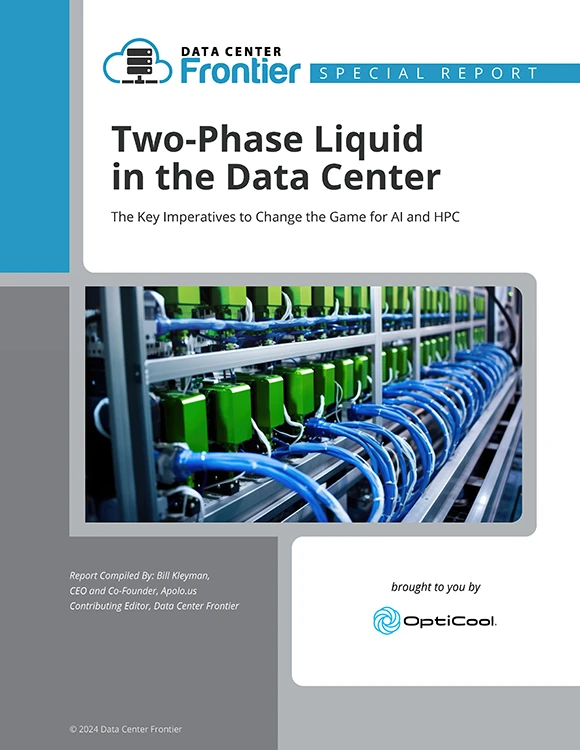Two-Phase Liquid Cooling
High-efficiency cooling through phase-change heat transfer
Refrigerants deliver superior cooling performance
Refrigerants are purposely designed to transfer heat, so naturally they perform better than water or air as a medium for heat transfer. The OptiCool system uses R-513A refrigerant, which has similar performance to the widely used R-134a but with a lower GWP (global warming potential) rating.
High efficiency two-phase cooling
The OptiCool system operates near the vaporization point of the refrigerant, where its heat capacity is by far the greatest. As the cool liquid refrigerant flows through the heat exchangers, it absorbs the heat and vaporizes into a gas. At the pump, external heat rejection takes the heat out of the gas and condenses it back into a liquid. Two-phase cooling refers to the mix of liquid and gas phases of the refrigerant in the system.
Because of the enormous heat capacity at the vaporization point, very little refrigerant is needed to absorb a lot of heat. The refrigerant flow rate is measured in gallons per hour, instead of gallons per minute for chilled water systems.
Two-phase cooling exploits physics and thermodynamics to do the heavy lifting. It eliminates the need for power-intensive compressors and expansion valves typically used in cooling systems. Power consumption is 90% less than an air-cooled system of a similar capacity.
Comparing data center cooling technologies
One of the key advantages of liquid cooled RDHx technology is that it combines the flexibility and ease of installation of traditional air-cooling with the high heat capacity and efficiency of direct-to-chip (DTC) liquid cooling. RDHx spans the range from low to high heat densities, offers high efficiency 2-phase savings compared to air-cooling, and has lower entry costs compared to direct-to-chip (DTC) systems.
RDHx and air-cooling both use air to transfer heat from the IT equipment: RHDx at the rack level, air-cooling at the room level. For RDHx, ambient air is pulled in from the front of the rack and absorbs the heat from the IT equipment. This heat is immediately extracted by the rear doors, and room-neutral ambient air is returned to the room.
Both are easy to install, can handle variable heat workloads, and are non-invasive to the IT equipment. Data center operators already familiar with air-cooling will be able to deploy RDHx technology with minimal additional effort and changes.
RDHx and DTC are both liquid cooling technologies designed for heat loads larger than what traditional air-cooling can handle. They are also more efficient. While DTC has a higher heat limit, this is achieved at the cost of more complex hardware and a less flexible design.
The chart below compares the three cooling technologies on the basis of installation costs, annual operating costs, and heat removal capacity.
Delta4T – our 4th generation cooling technology
OptiCool has rapidly accelerated the development of its groundbreaking Delta4T© technology. This progress has been made possible by leveraging our core team of engineers alongside more than 200 engineers and technicians from our parent company, Calvary Robotics. By integrating this collective expertise with advanced AI modeling software, we’ve effectively condensed years of development into a significantly shorter timeline.
The name Delta4T represents two core pillars of our innovation: Delta T, the temperature difference between supply and return water, a critical measure of cooling performance, and the fourth generation of our two-phase liquid cooling platform. This generation is purpose-built to handle both higher total heat capacities and dynamic fluctuations in the heat load.
What sets OptiCool apart is how we use refrigerant in the system. Unlike traditional cooling approaches that rely on refrigerant for compression cycles, we use it as the primary heat sink, allowing us to absorb and transfer heat more efficiently. Refrigerant’s superior thermal properties enable more effective cooling at lower energy consumption compared to single-phase water-based systems.
By using this more efficient cooling method, we are able to exceed the limits seen in traditional liquid cooling. That’s why Delta4T powers our industry-leading 120kW rear-door heat exchanger, a solution that demonstrates the full potential of high-capacity, energy-efficient thermal design.
Advantages of 2-phase liquid cooling
- Leverages latent heat of vaporization for enormous heat capacity
- Higher efficiency than air, water, or single-phase refrigerant cooling
- Much lower refrigerant flow rate and pump power
- Simple, elegant design results in high reliability and low maintenance cooling system
